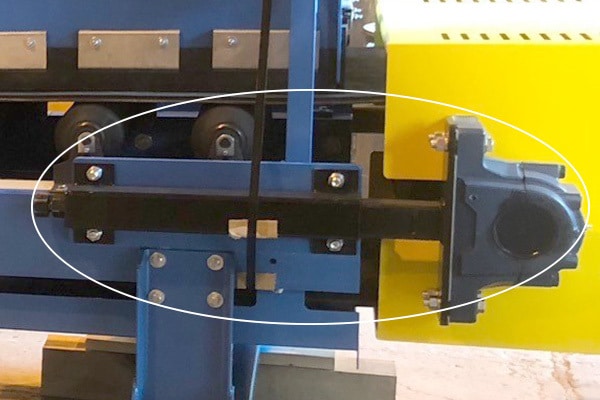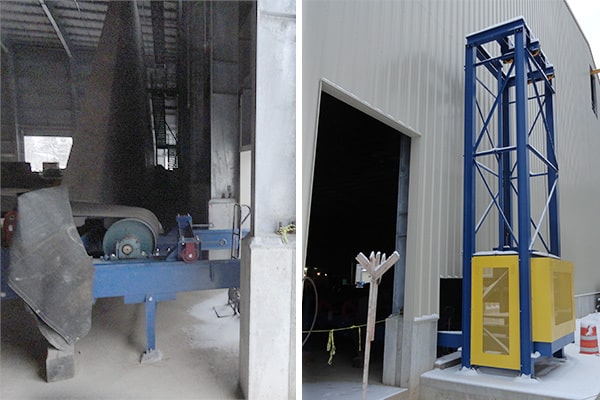The take-up on a belt conveyor is a key component in maintaining proper belt tension, which contributes significantly to process and mechanical stability. Proper belt tension helps to ensure that the belt wears evenly, material is contained in the trough, and the belt runs centrally over idlers.
While a few types of take-up are available for adjusting belt tension, the specific project parameters, along with customer preference, generally guide the decision on which type is best for a given application. The following covers the most commonly used types of take-up assemblies and when each type is most appropriate.
Why is Take-up Necessary?
Belt tension is a substantial factor in conveyor operation; belt tension that is too loose can cause a number of problems, including mistracking, unpredictable behavior, fugitive material, and excessive belt wear or damage. Tension that is too tight can also cause mistracking, fugitive material, and excessive belt wear, in addition to belt “cupping” (when the edges of the belt curl up), and an overstretched belt.
All conveyor belts will experience a certain amount of stretch. A general rule of thumb is to expect that a new belt will stretch an additional 2% of its total length. This stretch will add to the length of the belt, requiring any slack to be taken up in order to maintain proper tension.
The longer the conveyor, the greater the amount of stretch that will require take-up. For example, a 20’ conveyor will only have around 5” of stretch to accommodate, while a 300’ conveyor will have to manage six feet of stretch.
Take-up is also helpful when the belt requires maintenance, allowing the necessary amount of slack to be let out for operators or maintenance personnel to more easily make their repairs. When using a gravity take-up, FEECO recommends including some additional belt length in the design of the takeup. Including this buffer allows the ability for worn or damaged sections of belt to be cut out and re-spliced, rather than purchasing a new belt, minimizing downtime and cost.
Types of Belt Conveyor Take-ups
Take-up assemblies are available in many different types and styles, each offering its own advantages and disadvantages. The primary types of belt conveyor take-up are the screw (manual) take-up, gravity take-up (GTU), and horizontal take-up.
Screw Take-up
The screw take-up design utilizes mechanical force to take-up any slack in the belt. This is done by adjusting a threaded tensioning screw integrated into the conveyor frame on each side of the tail pulley. By adjusting the screw, the tail pulley can be either pushed outward or pulled inward.
Since this requires manual adjustment of the assembly, this style is often referred to as a manual take-up. Various styles of screw take-up are available based on customer preference and the level of duty required.
FEECO prefers the telescoping take-up screw. Another style, the top-angle take-up, is also popular, but requires a much larger and heavier tail frame, as well as larger guarding.
Screw take-ups offer a cost-effective means of managing belt tension for conveyors less than 150’ in length and are the standard take-up choice.

Telescoping screw take-up on a FEECO Belt Feeder
Gravity Take-up (GTU)
Screw take-ups are generally not suited to accommodate the length of belt stretch that occurs in conveyors longer than 150’ and in these settings, the gravity take-up is usually the best approach to belt tensioning.
A gravity take-up assembly utilizes three pulleys – two bend pulleys and one gravity take-up or sliding pulley – to automatically manage belt tension. A counter weight attached to the gravity take-up pulley pulls down on the belt to maintain tension via gravity. The bend pulleys direct belt slack around the gravity take-up pulley.
The entire assembly is incorporated into the bottom side of the conveyor frame and creates a constant tension on the belt. This self-tensioning setup allows the take-up to simply adjust to spikes in load or tension as it “floats” below the belt conveyor. As such, a gravity take-up assembly always maintains proper belt tension and avoids belt or take-up damage due to spikes in load or tension.
The self-tensioning nature of GTUs also means they require less maintenance than the screw take-up. Maintenance is typically only needed when the belt reaches the end of its life, having stretched so much that the assembly has reached the bottom of the allotted travel distance (the ability to see where the take-up falls in its allotted travel distance also provides a helpful visual cue to operators of roughly when maintenance may be needed). When this occurs, the conveyor belt will need to either be replaced or cut and revulcanized.
Because the gravity take-up system adjusts automatically to changes in belt tension, it is also known as an automatic take- up.
Horizontal Take-up
The horizontal take up is an alternative to the gravity take-up when space is a limitation.
This type of take-up is similar to the gravity take-up, but instead of the assembly situated below the belt, it is positioned vertically behind the tail pulley. This makes it particularly useful in situations where the conveyor is positioned on a grade that eliminates any additional space under the conveyor.
Since the horizontal take-up does not fall below the conveyor, a system of pulleys and cables is used to tension the belt with a weight box. The cabling attaches to the tail pulley, which rides on a carriage, allowing it to be moved in and out of place.

The image above shows a horizontal take-up: on the left, the tail pulley and carriage are installed on the inside of the building; and on the right, the weight box (behind guarding) is installed in a structure that will direct the cabling through pulleys (at the top) outside of the building (cables not yet installed).
Conclusion
Managing belt tension with the proper take-up is just one aspect of designing a customized bulk material handling system. FEECO conveyor systems are recognized for their heavy-duty build, intuitive design, and long-term reliability. All FEECO conveyors are engineered around the specific application and material at hand for an optimized handling solution. We also offer a comprehensive parts and service program for keeping conveyors running smoothly.
For more information on our custom material handling systems, contact us today!



